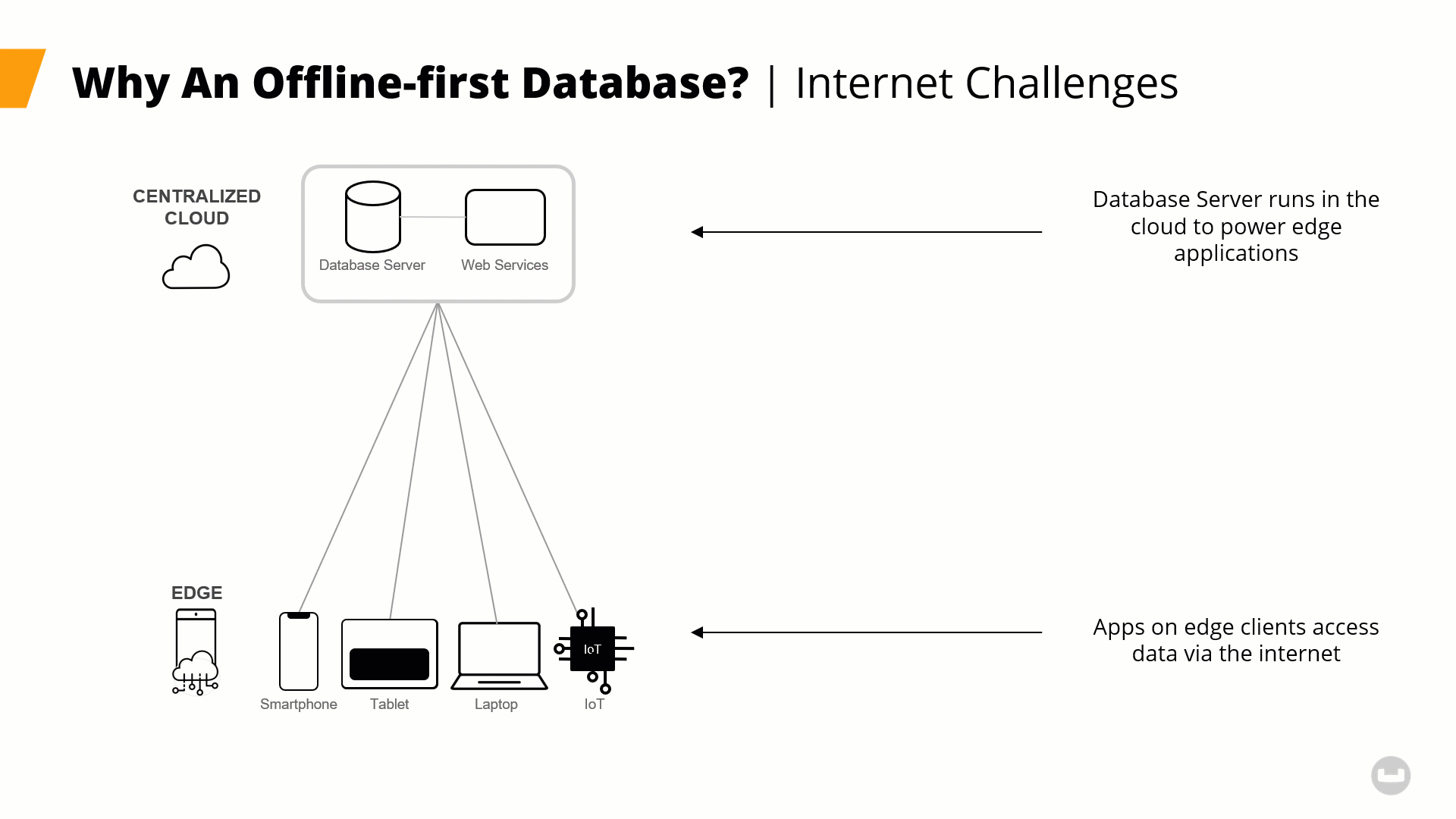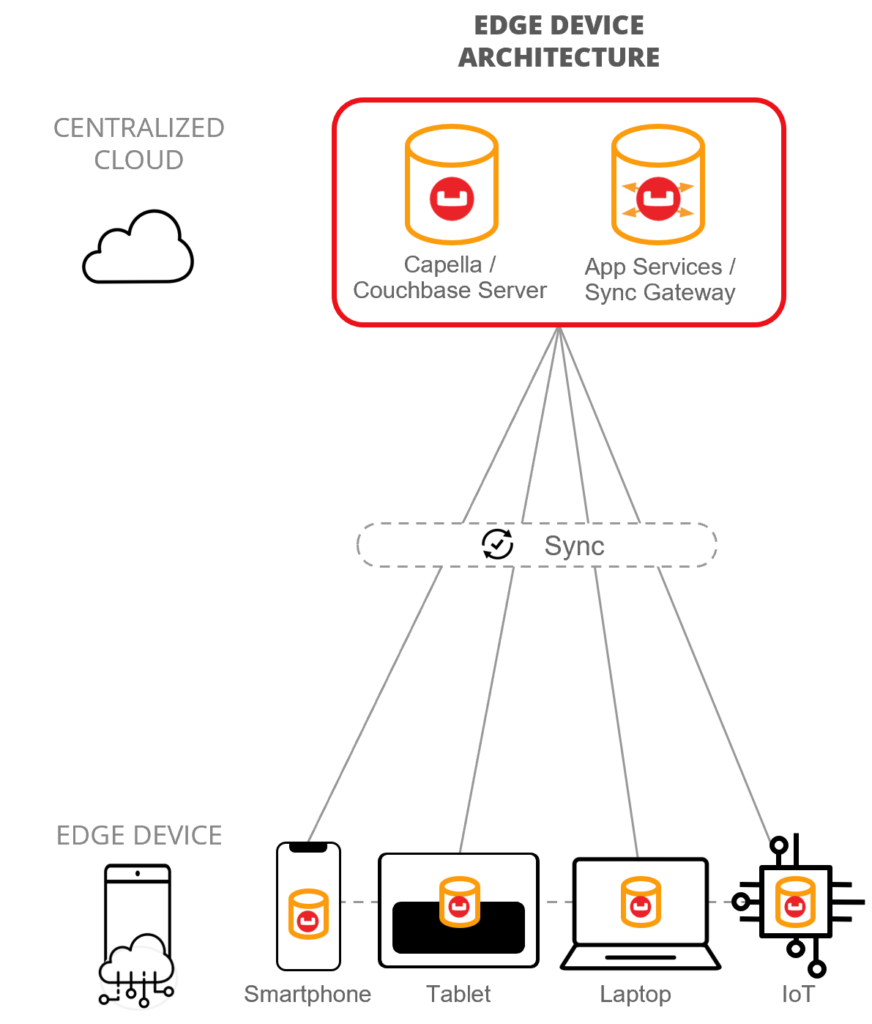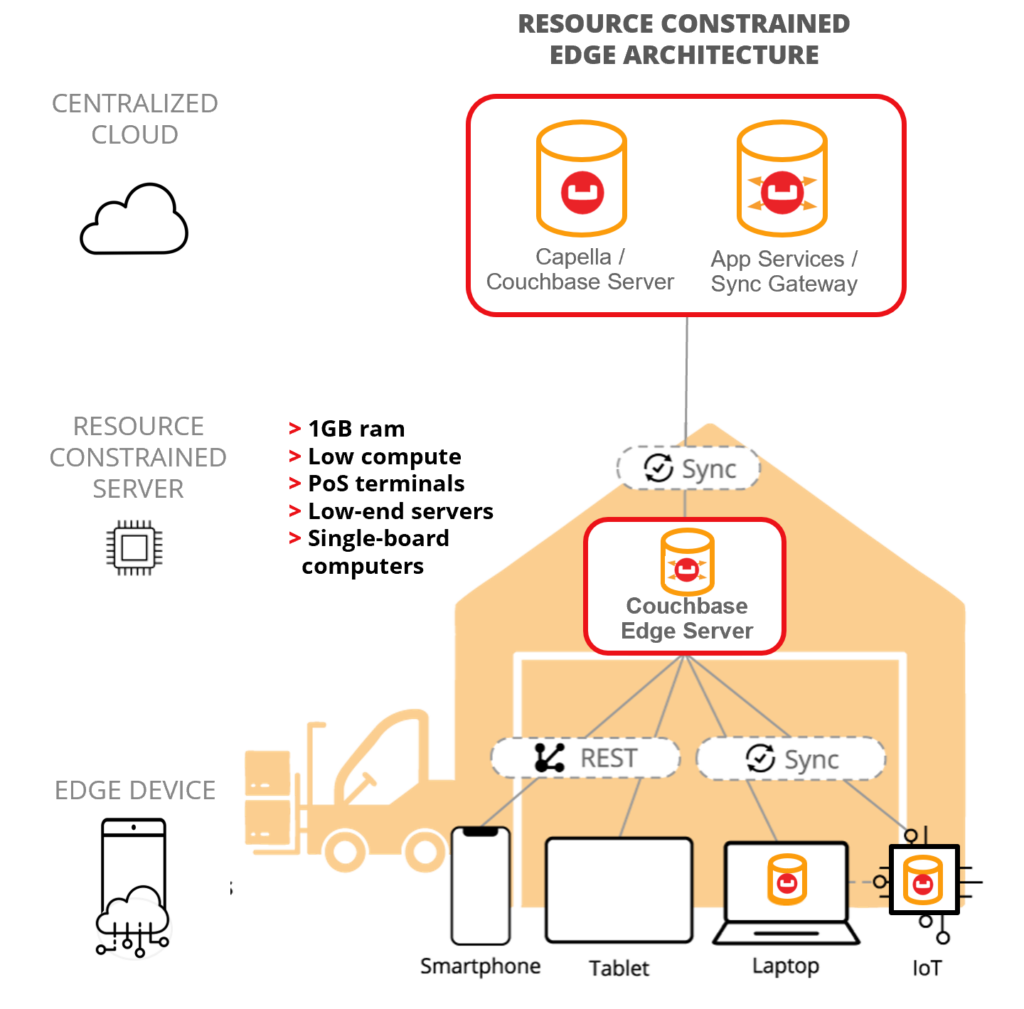If you’re a mobile developer using MongoDB for offline first mobile apps, you already know they have announced the deprecation of their mobile capabilities, namely, Atlas Edge Server, Atlas Device Sync, and Atlas Device SDKs (formerly known as Realm). These products EOL is coming in September of this year, so developers must find alternatives now. With this in mind, we at Couchbase would like to suggest moving to a unified end-to-end database platform with a proven track record and over 10 years of mobile support excellence: Couchbase Mobile. As such we thought an overview of product capabilities and use cases might help you make the decision to move.
Why do I need an offline-first mobile database anyway?

Cloud computing requires an internet connection.
With cloud computing architectures, apps running on edge clients access data via the internet located on distant database servers in the cloud. That’s fine for apps in areas where there is reliable internet connectivity and the clients are fairly fixed in-place. But for app clients that move in and out of network coverage, like mobile apps, or apps that need to run in isolated areas, like at sea or underground, it might be tough to get reliable internet. Even a retailer in the middle of a major city could find itself in an internet dead zone. As such, this architecture can present challenges.
When the internet is slow, or unavailable, the apps can’t access the data they need to operate, resulting in a poor user experience, and worse, business downtime! Internet connectivity issues with apps can be debilitating for user experience and for business, this is what drives the need for an offline-first database.
What is Couchbase Mobile?
Couchbase Mobile is a comprehensive unified end-to-end mobile database platform built for offline-first edge and mobile app development. It includes:
-
- A cloud-native database – Use Couchbase Capella, our hosted Database-as-a-Service, or install and manage Couchbase Server on your own public or private cloud.
- An edge-ready database – Deploy Couchbase Server at the edge to support thousands or more edge clients, and for resource constrained edge environments with a few hundred local clients you can deploy Edge Server.
- An embedded database – Couchbase Lite is the embeddable version of Couchbase for mobile and IoT apps that stores data locally on the device.
- Data sync from cloud to edge – A secure data sync gateway. Choose hosted data sync with Capella App Services, or install and manage Couchbase Sync Gateway yourself.
Gain cloud-to-edge AI
Couchbase Mobile goes beyond Realm and sets the stage for adding AI to your mobile apps because it supports vector search in Couchbase Capella, Couchbase Server AND Couchbase Lite. With vector search in Couchbase Lite, you gain the benefits of semantic search and RAG at the edge with no dependencies on the internet, which reduces data transfer costs, ensures better data privacy, and guarantees ultra low latency. And with the Couchbase Capella or Server backend also supporting vector search, you gain the ability to leverage semantic search from cloud to edge.
For a high level feature comparison of Couchbase Mobile vs MongoDB Atlas Device Sync (Realm), check out this comparison page, and for a deep dive SDK comparison, our engineers have created this Atlas Device SDK to Couchbase Lite Comparison Guide.
Couchbase Mobile architectures and use cases
Edge computing with Couchbase Mobile addresses issues of speed, reliability and security for apps at the edge by moving data storage and processing closer to the clients that use it and eliminating internet dependencies. Comprehensive support for a wide array of edge computing topologies allows for different use cases across a variety of industries and verticals. Here we will examine three common Couchbase Mobile edge architectures and explore some of the use cases they serve.
Edge device architecture
First let’s take a look at offline first field applications, where a defining characteristic of the app functionality is working in isolation with a need to operate even in a completely disconnected mode. For these types of conditions, Couchbase Lite supports the edge device architecture:

Couchbase Mobile supports the edge device architecture.
In the edge device architecture, Couchbase Lite runs within the apps codebase on device and syncs data with Couchbase in the cloud leveraging App Services or Sync Gateway. Another key here is the dotted line between the device, indicating peer-to-peer data sync between local apps, which is the ability to sync data with other local devices without requiring an internet connection or central cloud control point.
Edge device architecture use cases
A few ideal use cases for the edge device architecture include:
Insurance: With Couchbase Mobile powered apps, insurance agents making claims adjustments in the field can sell and update policy information in disaster areas where there is little or no network connectivity. And when connectivity is restored, automatic data sync ensures consistency across the app ecosystem.
Utilities: Inspectors at utility companies performing maintenance activities, working on equipment and conducting repairs need access to task lists, historic inspection results and infrastructure maps while in remote locations. Couchbase Mobile ensures their apps work everywhere all the time, regardless of internet connectivity.
Fast/casual restaurants: Many restaurants are looking to streamline the meal ordering and drive through order experience to serve more customers with fewer staff, and in many cases to extend services to the parking lot or curbside. Couchbase Mobiles embedded database and cloud-to-edge sync allows restaurant staff to take and adjust orders from mobile devices or digital kiosks without concern for an internet connection.
Mobile gaming: Couchbase Mobile’s embedded database ensures speedy responsive gameplay and a reliable experience for mobile games even in internet dead-zones. Built-in data synchronization allows gamers to change devices mid-game without missing a beat.
Edge location architecture
Now let’s examine a category of use case where there is a need to process large volumes of data in real time. In these cases, the data is predominantly generated at the edge as opposed to backend servers. A defining characteristic is the need to process data collected at these smart locations in real time. For these types of conditions, Couchbase Mobile supports the edge location architecture:

Couchbase Mobile supports the edge location architecture.
In the edge location architecture, we introduce an intermediate tier of data processing at the edge running Couchbase Server between the cloud and device layers. This middle tier could be servers on a cruise ship, within a multi-building campus, or on a Cloud Service Provider’s edge service, and we see Couchbase Lite running on the edge devices across the bottom syncing data across the tiers to the cloud, and between local devices via peer-to-peer. This tiered topology can be any number of layers deep, and Couchbase Mobile fits into the architecture perfectly because of its inherent ability to run and sync data anywhere, allowing for complex, multi-layered edge deployments.
Edge location architecture use cases
Some ideal use cases for the edge location architecture include:
Retail: Many next-gen retailers want to leverage AR and VR to create immersive apps for enhanced customer experience – such as smart mirrors that show customers how they would look in various styles and colors of clothing and recommend accessories. There are also cameras and scanners that track customers as they move through the store, which can enable personalized recommendations and smart shelves that record item selections and transact the purchase as customers leave. All of these capabilities require fast reliable access to data, and Couchbase Mobile delivers through its ability to store and sync data in the cloud, at the edge, and even on devices, eliminating internet dependencies.
Smart City: Smart cities use things like video surveillance to reduce crime, smart metering for more efficient street lighting, and smart traffic routing to manage traffic congestion. Technologies like 5G will only serve to drive more growth of these types of applications. In each example, the data volume and velocity can be immense, so Couchbase Mobile allows the city to process it locally in co-located edge data centers vs in a distant cloud datacenter to achieve the required realtime responsiveness.
Healthcare: In healthcare, Couchbase Mobile’s embedded data processing and cloud-to-edge sync allows hospitals to locally process patient monitoring data and provide real time diagnosis while adhering to data privacy regulations. Similarly, ambulances and medevac helicopters can serve as mini edge data centers where EMT staff can administer patient care and communicate patient status while en route to hospitals so they are better prepared to treat patients on arrival.
Resource constrained edge architecture
There are sometimes cases where there simply isn’t the computing infrastructure at the edge to run a full blown multi-node database server cluster. And in some cases, edge apps that are read-centric just need simple data access for a couple hundred clients in isolation, where an embedded database on device might be overkill. Couchbase Edge Server was built just for these conditions:

Couchbase Edge Server for resource constrained edge infrastructure.
Here we see Edge Server running on resource constrained hardware in a warehouse serving a community of local app clients, some of which are using REST to access data, and others synching data between Couchbase Lite and Edge Server via Websockets. Edge Servers small footprint, REST API, and built in data sync provide the perfect solution for resource constrained environments like this that need to serve a few hundred local clients. And when connectivity is available, Edge Server automatically syncs with Couchbase Capella or Couchbase Server in the cloud for long term data storage and analysis.
Resource constrained edge architecture use cases
Some ideal use cases for the resource constrained edge architecture include:
Airlines: Airlines that have digital seatback entertainment and meal ordering systems know they can’t rely solely on a cloud database to power the on-board apps, because that makes them dependent on the internet. But many commercial airlines aren’t allocating enough computing power and memory in their aircraft to run a full blown enterprise database server for on-board apps, especially fleets with older planes. Edge Server’s small footprint and built-in data synchronization provide the perfect solution for the airline seatback ordering system use case, allowing data to be processed onboard using the aircraft’s minimal computing resources while data sync between Couchbase in the cloud handles data consistency.
Stadiums: Large event venues like stadiums are digitizing their ticket gate turnstiles to speed fan entry and decrease foot traffic backups. Event venues can avoid internet slowdowns that lead to crowd control issues by deploying Edge Server near entry gates to power the scanners. Edge Server can even synchronize data with other Edger Servers to create a fully contained offline-first app ecosystem wholly disconnected from the internet.
Logistics warehousing: Warehouses are often in internet dead-zones and rarely have server-grade infrastructure on-prem, but they still need to power apps for things like inventory monitoring, robotic smartcarts and fulfillment processing. Edge Servers small footprint allows it to run on minimal hardware, and its offline-first capabilities allow warehouse apps to operate at peak speed and maximum availability regardless of internet.
Helpful resources
We’ve created some great resources to help you get started with migrating your mobile apps from MongoDB to Couchbase Mobile, including everything from high-level overviews and comparisons to deep-dive technical guides and how-to tutorials for developers:
Blogs
Comparison matrix
Webcasts
SDK comparison (for mobile developers)
How-to video tutorials
